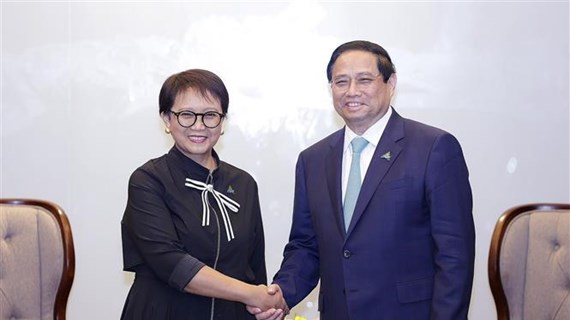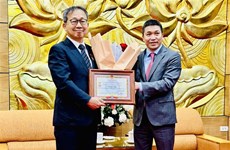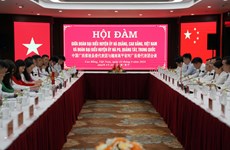Vietnam, Laos complete last border marker planting
The last marker of the VN-Laos border was inaugurated on July 9.
The last border marker of the Vietnam-Laos border was inaugurated at a
ceremony on July 9 at the gate separating the Vietnamese town of Thanh
Thuy in Nghe An province and the Lao town of Nam On in Bolikhamsay
province.
Prime Minister Nguyen Tan Dung and his Lao counterpart Thongsing Thammavong co-chaired the event.
The grand border marker – No. 460 - at the Thanh Thuy-Nam On gate signals the completion of increasing and upgrading border markers along the two countries’ shared boundary.
The event is of significance as it contributes to ensuring border security and building a border of peace, friendship, stability and cooperation for mutual development, creating favourable conditions for socio-economic development in the two countries and in the border region in particular.
The work manifests the mutual trust, understanding and high consensus reached by the two countries’ Parties, States and people.
It is a vivid symbol of the traditional friendship, special solidarity and comprehensive cooperation between the two countries based on the principle of respecting either side’s independence, sovereignty, territorial integrity and legitimate interests, as well as equality and common benefits for the interests of the two peoples.
Speaking at the ceremony, PM Dung stressed that the Party, State and Government of either side have always paid attention to the increase and upgrade of border markers.
“This is a common victory gained by the two countries in building their border of peace, stability and cooperation for mutual development,” he said.
The event has created favourable conditions for economic exchanges and cooperation between Nghe An and Bolikhamsay provinces while opening up new opportunities for economic, trade and investment links between businesses and investors of the two countries, the Vietnamese PM added.
According to the PM, the Thanh Thuy-Nam On gate is expected to become an attractive destination for investors and tourists at home and abroad.
PM Dung described the completion of planting border markers as the fruit of the Vietnam-Laos traditional friendship, special solidarity and comprehensive cooperation as well as of the friendship and faithful comradeship between the two countries.
Sharing PM Dung’s views, Lao Prime Minister Thongsing Thammavong said the project to increase and upgrade border markers along the two countries’ shared border has contributed to improving living standards and reducing poverty for people residing in the border areas.
He highly valued the efforts of the Vietnam-Laos Joint Committee on Border Marker Planting, relevant ministries, branches, localities and border demarcation forces in performing the task.
The PM affirmed the resolve of the Lao Government and people to partner with the Vietnamese Government and people in building the border of eternal friendship, peace, stability and cooperation for mutual development.
The two PMs called for close coordination and determination to fulfil the remaining parts of the work in 2014 agreed by the two countries’ high-ranking leaders.
Head of the Lao Border Committee Bun Kot Sang Som Sak briefed the ceremony on the five-year implementation of the project.
Along the 2,067km common boundary, 835 border markers have been planted in 793 positions, constituting a modern and solid border marker system, he said.
In the coming time, the two sides will enhance their cooperation and promptly build and sign legal documents such as the Protocol on Border Demarcation and Marker Planting, the new Agreement on Border Management Regulations and the Vietnam-Laos Border Gates and Border Gate Management Regulations in order to complete the entire project by 2014.
Ten Vietnamese provinces, Dien Bien, Son La, Thanh Hoa, Nghe An, Ha Tinh, Quang Binh, Quang Tri, Thua Thien-Hue, Quang Nam and Kon Tum border 10 Lao provinces, Phongsaly, Luang Prabang, Houaphan, Bolikhamsay, Khammoune, Savannakhet, Salavan, Xiengkhouang, Sepon and Attapeu.
The two countries first signed a 10-year agreement on border demarcation in July 1977. During the following period, the two sides planted 214 markers in 199 positions. The successful result was recognised in the protocol on border demarcation and border marker planting signed by the two neighbours in October 1987.
In 2003, the two sides completed a Vietnam-Laos border map at a scale of 1/50,000. However, it became clear that the old marker system was no longer suitable - the density of markers was too low. Furthermore, the markers had degraded significantly since their planting over 20 years before.-VNA
Prime Minister Nguyen Tan Dung and his Lao counterpart Thongsing Thammavong co-chaired the event.
The grand border marker – No. 460 - at the Thanh Thuy-Nam On gate signals the completion of increasing and upgrading border markers along the two countries’ shared boundary.
The event is of significance as it contributes to ensuring border security and building a border of peace, friendship, stability and cooperation for mutual development, creating favourable conditions for socio-economic development in the two countries and in the border region in particular.
The work manifests the mutual trust, understanding and high consensus reached by the two countries’ Parties, States and people.
It is a vivid symbol of the traditional friendship, special solidarity and comprehensive cooperation between the two countries based on the principle of respecting either side’s independence, sovereignty, territorial integrity and legitimate interests, as well as equality and common benefits for the interests of the two peoples.
Speaking at the ceremony, PM Dung stressed that the Party, State and Government of either side have always paid attention to the increase and upgrade of border markers.
“This is a common victory gained by the two countries in building their border of peace, stability and cooperation for mutual development,” he said.
The event has created favourable conditions for economic exchanges and cooperation between Nghe An and Bolikhamsay provinces while opening up new opportunities for economic, trade and investment links between businesses and investors of the two countries, the Vietnamese PM added.
According to the PM, the Thanh Thuy-Nam On gate is expected to become an attractive destination for investors and tourists at home and abroad.
PM Dung described the completion of planting border markers as the fruit of the Vietnam-Laos traditional friendship, special solidarity and comprehensive cooperation as well as of the friendship and faithful comradeship between the two countries.
Sharing PM Dung’s views, Lao Prime Minister Thongsing Thammavong said the project to increase and upgrade border markers along the two countries’ shared border has contributed to improving living standards and reducing poverty for people residing in the border areas.
He highly valued the efforts of the Vietnam-Laos Joint Committee on Border Marker Planting, relevant ministries, branches, localities and border demarcation forces in performing the task.
The PM affirmed the resolve of the Lao Government and people to partner with the Vietnamese Government and people in building the border of eternal friendship, peace, stability and cooperation for mutual development.
The two PMs called for close coordination and determination to fulfil the remaining parts of the work in 2014 agreed by the two countries’ high-ranking leaders.
Head of the Lao Border Committee Bun Kot Sang Som Sak briefed the ceremony on the five-year implementation of the project.
Along the 2,067km common boundary, 835 border markers have been planted in 793 positions, constituting a modern and solid border marker system, he said.
In the coming time, the two sides will enhance their cooperation and promptly build and sign legal documents such as the Protocol on Border Demarcation and Marker Planting, the new Agreement on Border Management Regulations and the Vietnam-Laos Border Gates and Border Gate Management Regulations in order to complete the entire project by 2014.
Ten Vietnamese provinces, Dien Bien, Son La, Thanh Hoa, Nghe An, Ha Tinh, Quang Binh, Quang Tri, Thua Thien-Hue, Quang Nam and Kon Tum border 10 Lao provinces, Phongsaly, Luang Prabang, Houaphan, Bolikhamsay, Khammoune, Savannakhet, Salavan, Xiengkhouang, Sepon and Attapeu.
The two countries first signed a 10-year agreement on border demarcation in July 1977. During the following period, the two sides planted 214 markers in 199 positions. The successful result was recognised in the protocol on border demarcation and border marker planting signed by the two neighbours in October 1987.
In 2003, the two sides completed a Vietnam-Laos border map at a scale of 1/50,000. However, it became clear that the old marker system was no longer suitable - the density of markers was too low. Furthermore, the markers had degraded significantly since their planting over 20 years before.-VNA













